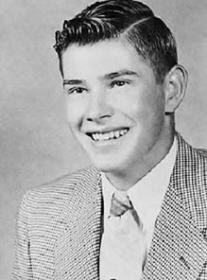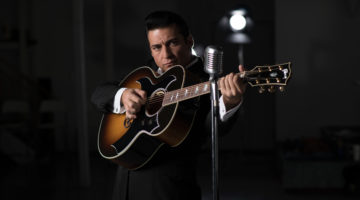Local Iowa News Story: Could new investigation clear Buddy Holly pilot?
A flight expert is appealing to the National Transportation Safety Board for a new investigation into the Iowa crash that killed rock and roll pioneer Buddy Holly – an investigation that could clear the name of the 21-year-old pilot from Alta who flew the 1947 Beechcraft Bonanza 35 V-tail on February 3, 1959, dubbed “The Day the Music Died.”
L. J. Coon, a pilot and aircraft dispatcher who has worked with the Transportation Safety Administration, has been campaigning for over two years to convince the NTSB to re-open the case.
His bid to erase the original determination of “pilot error” as the cause for the fatal crash was denied in March, 2015, but this month, the General Counsel for the NTSB suddenly reversed its stance and agreed to consider his request to re-open the case. That deliberation began January-6-2017 Coon said. He submitted 52 full pages / pdf of research.
“A lot of stuff that has been written about this accident over the years just wasn’t so,” he told the Pilot-Tribune.
For example, Coon says, reports claim Peterson was inexperienced, while records show he had logged 210 hours in the Beechcraft Bonanza 35 V-tail. His employer Dwyer Flying Service was FAA certified to conduct VFR chartered flights both day and night and had always maintained that Peterson was not at fault and that the ruling in the investigation was wrong, but Dwyer was not allowed to speak at the hearings in 1959.
Also, the original investigation claimed that the plane had left the Mason City airport into a snowstorm (there was no hollywood snow storm), weather records and living eyewitnesses maintain that the weather was clear, and that snow did not begin until the next morning hours after the the Beech Bonanza 35 V-tail touched down in a stubbled farm field right wing tip first with it’s nose lowered slightly. The very first photo’s from the scene (around 9:30 a.m.) provided images that were not snow covered. These surfaces would have been there on the stubbled farm field since 0058Z (around eight and a half hours). The aircraft, The wing surface, The aircrafts exposed interior, The aircrafts compass had been laying on the farm field all night long and not snow covered, The tops of fence post. There was a dusting of snow after (9:30 a.m.) and the historic photo’s show those images of the investigators in that fallen snow. There were four adult witnesses that night, and they have all stated that it was not snowing, when the aircraft departed at 0055Z
The aircraft departed at 0055Z The Beech Bonanza 35 V-tail flew for 3.5 minutes then began a witnessed normal slow descent from 800′ AGL that ended 4.9 miles from the mason city airport just before 1 a.m. and despite no radio contact, law enforcement did not search for it. The crash site was eventually located by the plane’s owner flying the flight path the next day. Reporters and onlookers wandered amid the wreckage, so investigation details are sketchy.
Coon proposes a few different possible factors contributing to the crash that were ignored in the original findings.
The plane’s magneto (ignition) power control was in the off position when the wreckage was found, which may indicate that the plane’s engine was not running properly, and Peterson suspected magneto failure and tried to respond, Coon says. To turn the magneto off required manipulating the control by key for three separate clicks. It should be noted that the coroner found Peterson with his right thumb freshly amputated and forefinger with a circular laceration (This was the only time in the coroners report that the term freshly amputated was used), indicating that the pilot may have been desperately gripping the magneto key even as the plane touched the stubbled farm field, right wing tip first with it’s nose lowered slightly.
Also, Coon suggests, a last minute decision had been made to change two of the passengers in the small plane, with their luggage. There would not have been time to re-adjust the nose weight and balance of the plane before take-off, according to Coon, and the size of the three performers would have put the plane at or close to its maximum limit.
He also wants the NTSB to review receipts to ensure that the plane was properly loaded with enough fuel before take-off. He noted that there was no fire after the crash, and none of the accounts mentioned a spill or smell of aviation gas at the scene. Information on the plane’s fuel gauges was missing from the investigation documents, Coon said.
1947 Beechcraft Bonanza 35 V-tail fuselage also had a history of in-flight structural issues (wing structure and V-tail), he said, and he questions whether the previous owners-installation of the Sperry attitude gyro instruments had been an issue after being flown for 210 hours coast to coast both day and night with the instrument right in front of Peterson.
Also, that plane model had a peculiar placement of the rudder pedals near the front seat passenger. Coon feels it is possible that Holly twisted in his seat to speak to the rear passengers and may have accidentally contacted the pedal, causing the aircraft to veer sideways. Some owners of this plane model had the pedal moved for just such a reason.
Finally, a witness who saw the plane pass directly above her house near Fertile, swears that it had a landing light on, indicating that Peterson had the where withal to reach down and turn on the landing light was experiencing serious problems on board and searching for a spot in a field to attempt an emergency landing.
Dwyer Flying Service knew about the historic flight days in advance. The plane was chartered by the Surf Ballroom after Holly became frustrated with winter bus travel, to go from his last gig in Clear Lake to Fargo, North Dakota, where he would be picked up for his next concert nearby in Minnesota.
Band member Waylon Jennings planned to accompany Holly, but gave up his seat to an ailing J.P. “Big Bopper” Richardson. With one seat left, a coin toss gave it to 17-year-old opening act performer Ritchie Valens. Both singers died with Holly and the pilot when the plane went down in a field about five miles from the Mason City airport where it had taken off less than five minutes earlier.
Numerous rumors and theories have been floated about the crash over the years, but there is no evidence to back them up. Among them was that a gunshot had gone off in the plane, as a revolver was found on the scene that had apparently been carried by Holly, with reports indicating that two bullets were missing. Another theory held that the crash occurred when passengers attempted to change seats in flight, which is impossible to prove or disprove because the three performers were all ejected from the wreckage. Only Peterson’s body was still in the plane.
There was a huge outcry of grief for Holly at the time of his funeral, while Peterson was quietly laid to rest at Buena Vista Memorial Park Cemetery at Storm Lake with a small headstone featuring a tiny etching of a plane.
“He was a young man who built his life around flying,” the Civil Aeronautics Board reflected in its official report following the crash. He had begun flying at age 16, had his license just after graduating high school, and by 21, had over 700 hours of flight experience, and a year as a charter flight pilot and flight instructor under his belt.
The eldest of four children, Peterson had married his high school sweetheart, Deanne Lenz, the September before. They had just established a home in Clear Lake. A passionate and respected young pilot, his career seemed assured.
For the rest of their lives, Peterson’s parents, Arthur and Pearl, who continued to live in Alta, hoped that their son would be remembered in the same breath with the more famous personalities lost in the crash. They received letters of condolence from the families of Holly and Valens.
Peterson indeed has been remembered – an international group of Holly fans in the 1990’s started to present a music scholarship, a memorial tree to Peterson was planted at the crash site. His role in the tragedy is also recalled in movies and biographies of each of the performers.
On what would have been the pilot’s 71st birthday, a visitor to an online memorial site wrote for Peterson said, “May you always be soaring above the clouds!”
“You are most likely the one person’s name that day that no one remembers, but you did your best,” another wrote.
As for the campaigner Coon, he still believes that if the NTSB agrees to re-investigate the crash, it will find that far from a fatal mistake, the young pilot acted “heroically” in the fateful four minutes of his final flight.




No Comment